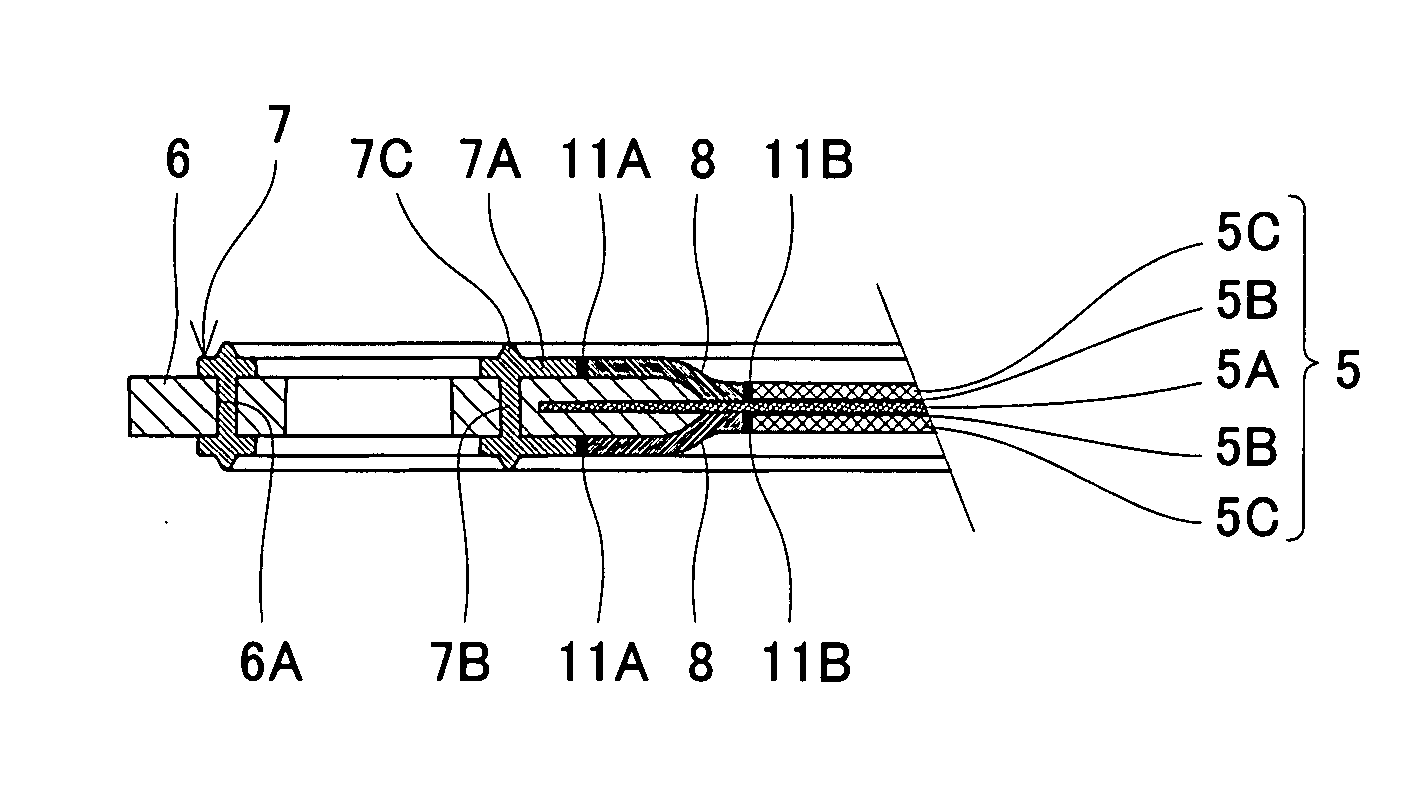Mea-Gasket Assembly and Polymer Electrolyte Fuel Cell Using Same
- Summary
- Abstract
- Description
- Claims
- Application Information
AI Technical Summary
Benefits of technology
Problems solved by technology
Method used
Image
Examples
first embodiment
[0106]FIG. 1 is a view illustrating a structure of an MEA-gasket assembly according a first embodiment, wherein FIG. 1(a) is a plan view (cathode separator side) and FIG. 1(b) is a sectional view taken along line I-I of FIG. 1(a).
[0107] As illustrated in FIG. 1, the MEA-gasket assembly 1 of the first embodiment has an MEA 5. In the MEA 5, a catalyst layer 5B and a gas diffusing layer 5C are stacked in order on each surface of a part (inner part) of a polymer electrolyte membrane 5A, the part excluding the peripheral region (periphery) of the membrane 5A.
[0108] An annular frame 6 (in this embodiment, the frame takes the form of a substantially square plate) is provided so as to hold the peripheral region of the polymer electrolyte membrane 5A of the MEA 5 and to enclose the outer peripheral edge of the polymer electrolyte membrane 5A. Herein, the frame 6 is made of plastic resin. The frame 6 is disposed such that an annular gap is formed between the inner peripheral edge of the fra...
example 1
[0156] The following performance test was conducted on the polymer electrolyte fuel cell of the first embodiment.
[0157] 1. Cross Leak Resistance Test
[0158] The openings of the oxidizing gas manifolds of the polymer electrolyte fuel cell of the first embodiment were sealed. The reducing gas manifolds were pressurized to 0 to 200 KPa by use of dried nitrogen gas, and the amount of dried nitrogen gas leaking to the oxidizing gas manifolds was measured.
[0159] As a result, a leak of the dried nitrogen gas to the oxidizing gas manifolds was not detected even when the reducing gas manifolds were pressurized up to 200 KPa.
[0160] 2. Anode Pressure Loss Test
[0161] Dried nitrogen gas of 3 to 20 NL was allowed to flow in the reducing gas manifolds of the polymer electrolyte fuel cell of the first embodiment and the loss of pressure was measured.
[0162] As Comparative Example 1, a polymer electrolyte fuel cell was used which had the same structure as of the first embodiment except that the ...
second embodiment
[0171] The polymer electrolyte fuel cell of the second embodiment is the same as that of the first embodiment except the material of the frame of the MEA-gasket assembly 1; the shapes of the main faces of the MEA-gasket assembly 1, the anode separator 2 and the cathode separator 3; and the layout of the manifold holes. Therefore, in the second embodiment, only the points different from the first embodiment will be explained.
[0172]FIG. 11 is a plan view (anode separator side) showing a structure of the MEA-gasket assembly 1 of the second embodiment.
[0173] As the material of the frame 6, glass fiber containing polypropylene (produced by Idemitsu Petrochemical Co., Ltd. and marketed under the name of R350G) is used. The first gasket 1 is made of Santoprene 8101-55 (produced by Advanced Elastomer Systems), that is, a thermoplastic elastic material, similarly to the first embodiment. Since the first gasket 7 and the frame 6 both have polypropylene as a plastic component, the first gask...
PUM
| Property | Measurement | Unit |
|---|---|---|
| Pressure | aaaaa | aaaaa |
| Pressure | aaaaa | aaaaa |
| Pressure | aaaaa | aaaaa |
Abstract
Description
Claims
Application Information
 Login to View More
Login to View More - R&D
- Intellectual Property
- Life Sciences
- Materials
- Tech Scout
- Unparalleled Data Quality
- Higher Quality Content
- 60% Fewer Hallucinations
Browse by: Latest US Patents, China's latest patents, Technical Efficacy Thesaurus, Application Domain, Technology Topic, Popular Technical Reports.
© 2025 PatSnap. All rights reserved.Legal|Privacy policy|Modern Slavery Act Transparency Statement|Sitemap|About US| Contact US: help@patsnap.com



